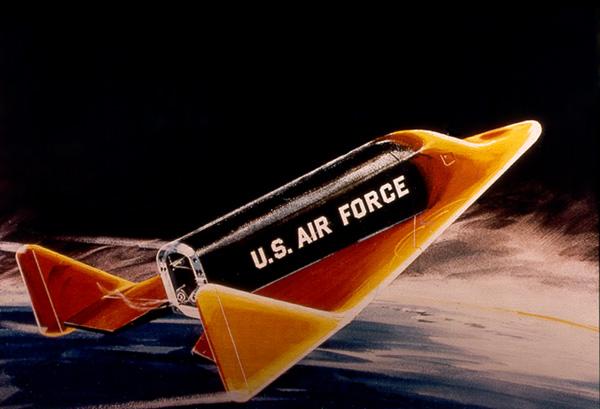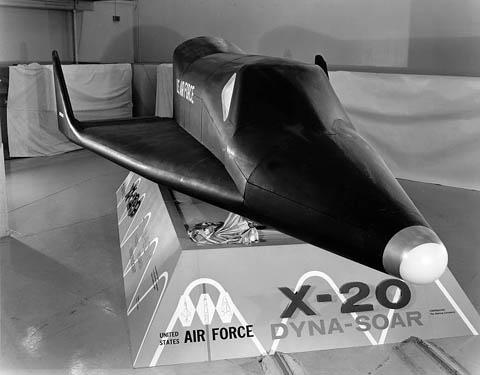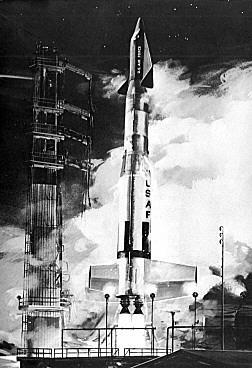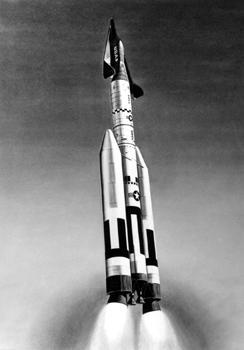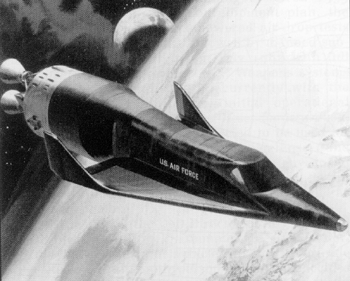|
|
||||||
The X-20 would have predated the Space Shuttle by 15 years - but it never had the chance The X-20 Dynamic Soaring or "DynaSoar" vehicle was one of the earliest American space programs. A purely military vehicle, it was inspired by the World War II Sanger-Bredt Silverbird intercontinental skip-glide rocket bomber envisioned by Nazi Germany for the Luftwaffe. German scientists who had worked on the "Skip Bomber" found work with Bell after the war; they pitched the idea to the Pentagon, who naturally put out a request for bids on the project-and awarded it not to Bell, but to Boeing.
The semi-winged DynaSoar evolved greatly. The basic idea was to lob the bird into low Earth orbit and skip across the upper atmosphere like a rock across a pond, a concept then known as "dynamic soaring." Then some wag decided to shorten the term to "DynaSoar"-perhaps forgetting the fate that awaited the craft's prehistoric namesakes! As with the International Space Station decades later, the X-20 went through many changes in mission and configuration. Originally, it was supposed to result in a manned orbital bomber; later, its mission was changed to become a reconnaisance platform. Then a proposal was developed that would have seen three stages in development-DynaSoar I, II, III, and finally the operational DynaSoar Manned Orbital Weapons System (MOWS). The whole thing had been planned during the 1950s as an advanced follow-on to the X-15 program; lessons learned on the X-15 and the proposed 2-seat X-15B would have been applied directly to the X-20 program. DynaSoar's original configuration called for a single pilot and a payload bay behind him, which could have housed a satellite, research, or weapons payload. Still another concept for the vehicle called for a module containing reconnaissance equipment and a modular cockpit for an SR-71-style Reconnaissance Systems Officer (RSO).
When the X-20 was under development in the late 1950s and early 1960s-at the dawn of the Space Age-there were several possibilities for a launch vehicle. Initial glide flights would be flown X-15-style from under the wing of a B-52 at Edwards. These flights would investigate and develop the X-20's approach-to-landing characteristics and piloting technique, using X-15 data and experience as a model. When it came time to fly the bird in space, the Air Force looked at several new launch vehicles-the Titan I (above), the Titan II, a variant of the big NASA Saturn I, and finally, the Titan III (below). Since a man-rated Titan III was already being developed expressly for the Air Force (for Manned Orbiting Laboratory use), it was decided that the X-20 would use this as its launch vehicle.
Later X-20 plans called for a heavier
launch vehicle. The natural choice for this USAF mission was the Titan
III, shown here in yet another artist's rendering. A man-rated version
of the Titan III was also slated for use on the MOL program.
     
USAF & NASA Photos These were the men selected by the Air Force in 1962 to fly the X-20. From left: Albert H. Crews, Jr.; Henry C. Gordon; William J. "Pete" Knight; Russell L. Rogers; Milton O. "Milt" Thompson; and James W. Wood. Crews was later selected for the MOL program; after MOL was cancelled in 1969, he transferred to NASA Flight Crew Operations at the Johnson Space Center in Houston. He remained at NASA as a pilot until his retirement at age 65. Henry Gordon later retired from the USAF as a colonel; he passed away on September 24, 1996, of natural causes. Pete Knight earned his USAF Astronaut Wings in the X-15 on October 17, 1967. On his previous rocket plane flight, in the X-15A-2 two weeks earlier, he set an unofficial world speed record that has never been broken by a manned aircraft within the atmosphere-4,509 MPH. After that flight, the airframe was so scorched that it was grounded and never flew again. Russell L. Rogers was later killed when his F-105 exploded at Kadena AFB, Okinawa, September 13, 1967. Milt Thompson later gained fame as an X-15 and Lifting Body pilot, and was one of the few guys who spun an X-15 and lived to tell the tale (January 13, 1965). One of the most well-known NASA test pilots, Milt was the only civilian selected to fly the X-20. In October 1966 he became Director of Research Projects at NASA's Dryden Research Center, Edwards AFB. He died of natural causes on August 6, 1996. James Wood had been the senior project pilot of the group, and thus would have made the X-20's first manned single-orbit space flight. He remained in the Air Force, serving as Commander, Test Operations, Edwards AFB. Wood retired from the USAF with the rank of Colonel, and passed away on New Year's Day, 1990, of natural causes at age 75.
The mission profile for the DynaSoar's initial orbital missions called for a launch on a Titan I or Titan III from Cape Canaveral Air Force Station, attaining altitudes of nearly 500 miles, followed by a controlled re-entry and an X-15-style landing on Rogers Dry Lake at Edwards AFB. Then-Secretary of Defense Robert S. McNamara was never a big fan of the X-20. He wanted the MOL program instead, and so subjected the X-20 to what became known as "paralysis by analysis"-a common tactic of his, wherein a popular program he didn't like would be subjected to endless requests for progress reports and inquiries and other such meddling by the Pentagon and Congress. When Congress got wind of the resulting delays and cost overruns, they would launch their own investigation, cry foul over the budget, and bury the program in its own paperwork until they had no choice but to cancell it. Then McNamara would have an excuse to champion his own program, which would seem cheaper by comparison. Accordingly, McNamara announced the cancellation of the X-20 DynaSoar project at a news briefing on December 10, 1963, at the Pentagon-barely a year after the first group of X-20 pilots had been named. McNamara said at the time that fiscal resources thereby "saved" would be channeled into "broader research on the problems and potential value of manned military operations in space"-namely (surprise!) the MOL project....These decisions on the X-20 and MOL had been discussed and coordinated with NASA, and, although the Air Force received responsibility for the MOL project, NASA would continue to provide technical support. And that's how the X-20 DynaSoar became extinct.
Artists' concept of the Boeing X-20 DynaSoar in orbit, with transtage section still attached. The X-20 was cancelled on December 10, 1963, in favor of the Gemini-Titan-based Manned Orbital Laboratory (MOL)-which was also eventually cancelled. (That was the same day that Chuck Yeager was injured ejecting from a tumbling NF-104A, as shown at the end of The Right Stuff.) Had the DynaSoar program continued, air-drop test flights from a B-52 would have began in May 1965, with manned orbital tests beginning the following year-predating the Space Shuttle by about 15 years. SOURCE: SPACE COWBOY'S SALOON |
||||||
| SEE ALSO: | ||||||
| FAIR USE NOTICE: This page contains copyrighted material the use of which has not been specifically authorized by the copyright owner. Pegasus Research Consortium distributes this material without profit to those who have expressed a prior interest in receiving the included information for research and educational purposes. We believe this constitutes a fair use of any such copyrighted material as provided for in 17 U.S.C § 107. If you wish to use copyrighted material from this site for purposes of your own that go beyond fair use, you must obtain permission from the copyright owner. | ||||||
|
|
